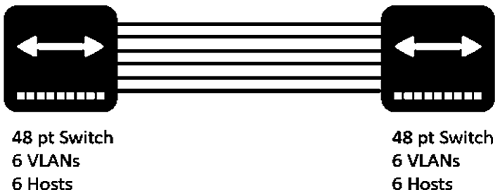Home »
Computer Network
Virtual LAN (VLAN) in Computer Network
Computer Network | Virtual LAN (VLAN): In this tutorial, we will learn about the Virtual LAN (VLAN), its example, how does it work, types of VLANs, features, advantages, and disadvantages.
By Rahul Gupta Last updated : May 05, 2023
What is Virtual LAN (VLAN)?
Virtual Local Area Networks or Virtual LANs (VLANs) are a logical group of computers which is the configuration of the underlying physical network; seem to be on the same LAN. To match the functional specifications of the VLANs, network administrators set the networks so that each VLAN consists of a subset of ports on single or multiple switches or bridges. This enables computers and devices inside a VLAN to communicate as though they were a separate LAN in the simulated world.
Example of VLAN
In the example below, on 6 switches with different VLANs, there are 6 hosts. To connect the switches, you need 6 ports. That means, if you have 24 separate VLANs, 45 port switches will have just 24 hosts.

How VLAN's work?
When a workstation receives information from a LAN bridge, it marks the data with a VLAN identifier showing the VLAN from which the data came. Explicit marking is called this. It is also possible, using implicit labelling, to specify the VLAN the received data belongs to. The data is not tagged in implied tagging, but the VLAN from which the data originated is calculated based on other facts, such as the port on which the data arrived. Tagging may be based on the port from which it originated, the Media Access Control (MAC) source field, the address of the source network, or some other field or field combination.
Based on the system used, VLAN's are graded. To be able to do the tagging of data using any of the methods, the bridge will have to hold an updated database containing a mapping between VLAN's and whatever field is used for tagging. If tagging is by port, for example, the database should indicate which ports belong to which VLAN. A filtering database is called this database. Bridges will have to be able to manage this database and also to make sure that all the bridges on the LAN have the same information in each of their databases. Based on standard LAN operations, the bridge decides where the data is to go next. Once the bridge decides where the information is to go, it now needs to decide whether to add and submit the VLAN identifier to the data. The VLAN identifier is applied to the information if the data is to go to a computer that knows about the VLAN implementation. The bridge sends the data without the VLAN identifier if it is to go to a computer that does not know the VLAN implementation.
Types of VLANs
The following are the types of VLANs:
- Protocol VLAN: Based on its protocol, which has traffic controlled. Depending on the traffic protocol, a switch segregates or forwards traffic.
- Port-based VLAN: This is called static VLAN as well. Here, the network administrator assigns a virtual network to the ports on the switch/bridge.
- Dynamic VLAN: In contrast to the switch port location, a network administrator may identify network membership based on system characteristics.
Features of VLANs
The following are the features of VLANs:
- In the existing network infrastructure, VLANs remove the need to run new cables or to reconfigure physical connections.
- VLANs, because they are created by logical relations, are more versatile than physical LANs. This helps to reconfigure systems faster and cheaper if the logical partitioning has to be altered.
- To shape several, independent VLANs, there may be one or more network bridges or switches.
- VLANs also have improved security management, enabling devices to be partitioned according to their safety requirements, as well as providing a higher level of control of connected devices.
Advantages of VLAN
Followings are the main advantages of VLAN:
- Performance - There is plenty of broadcast and multicast network traffic. The need to submit such traffic to an unwanted destination is reduced by the VLAN. If the traffic is intended for 2 users, but 10 devices are present in the same broadcast domain, all will then receive the traffic, i.e. bandwidth wastage, but if we make VLANs, then only the intended users will receive the broadcast or multicast packet.
- Formation of Virtual Workgroups - Cross-functional product development teams are commonly found with members from various departments, such as marketing, sales, accounting, and research. Typically, these workgroups are created for a limited time. Communication between members of the workgroup will be high during this time. A VLAN can be set up for them to contain broadcasts and multicasts within the workgroup. With VLAN, it is easier to bring together members of a working group. Without VLANs, the only way this will be feasible is to physically bring all the members of the workgroup closer together.
- Security - Sensitive data that can be accessed by the outsider can be transmitted on the same network, but by creating VLAN, we can control broadcast domains, set up firewalls, limit access. To warn the network manager of an intrusion, VLANs may also be used. VLANs, therefore, significantly boost network security.
- Flexibility - VLAN offers the flexibility to add and delete the host number we want.
- Reduced Cost - To build broadcast domains that remove the need for costly routers, VLANs can be used.
Disadvantages of VLAN
Followings are the disadvantages of VLAN:
- A packet can leak to others from one VLAN.
- An injected packet can contribute to a cyber-attack.
- Threats can spread a virus across a whole logical network in a single device.
- To monitor the workload on large networks, you need an external router.
- You can face interoperability issues.
- A VLAN is unable to forward network traffic to other VLANs.
Advertisement
Advertisement